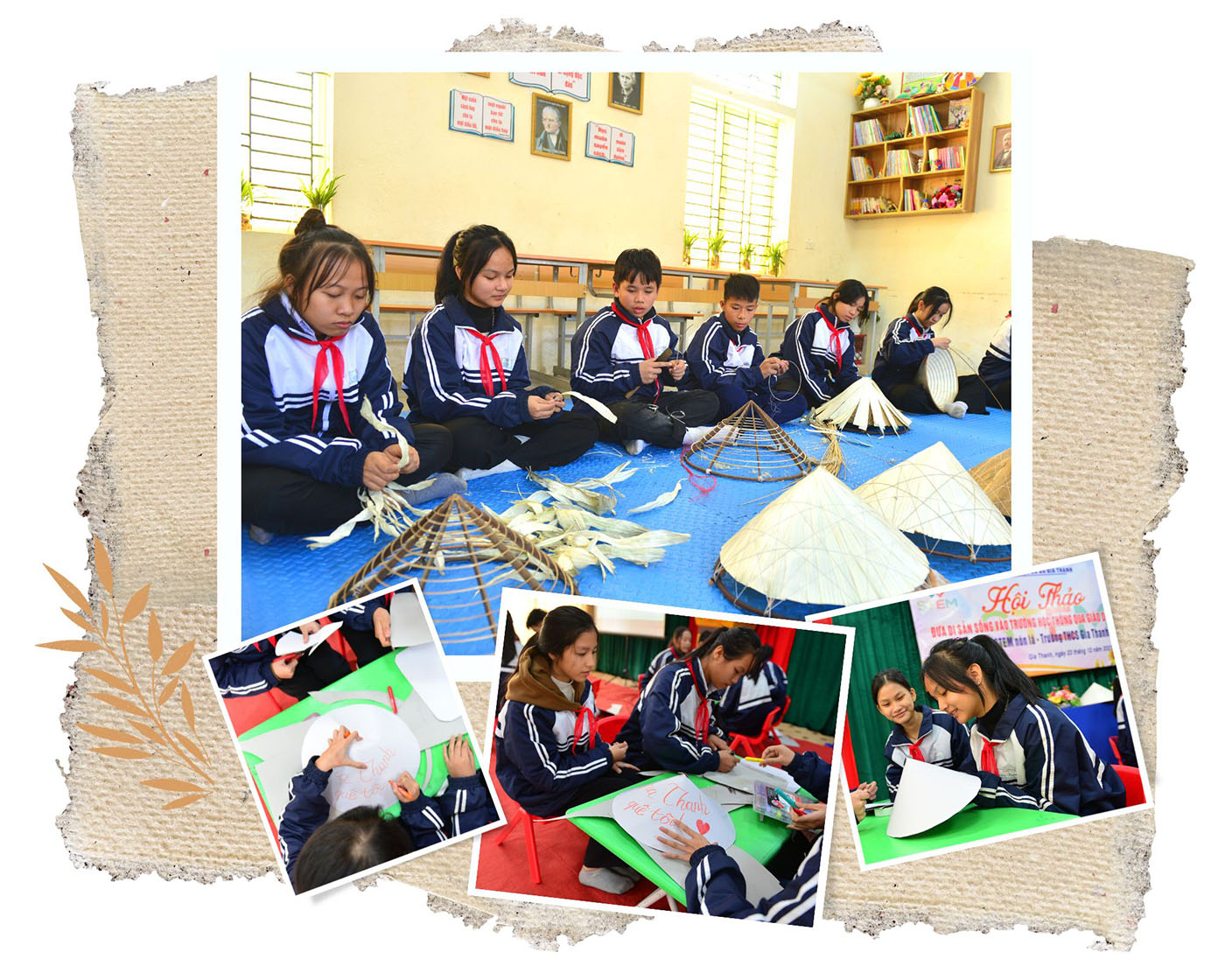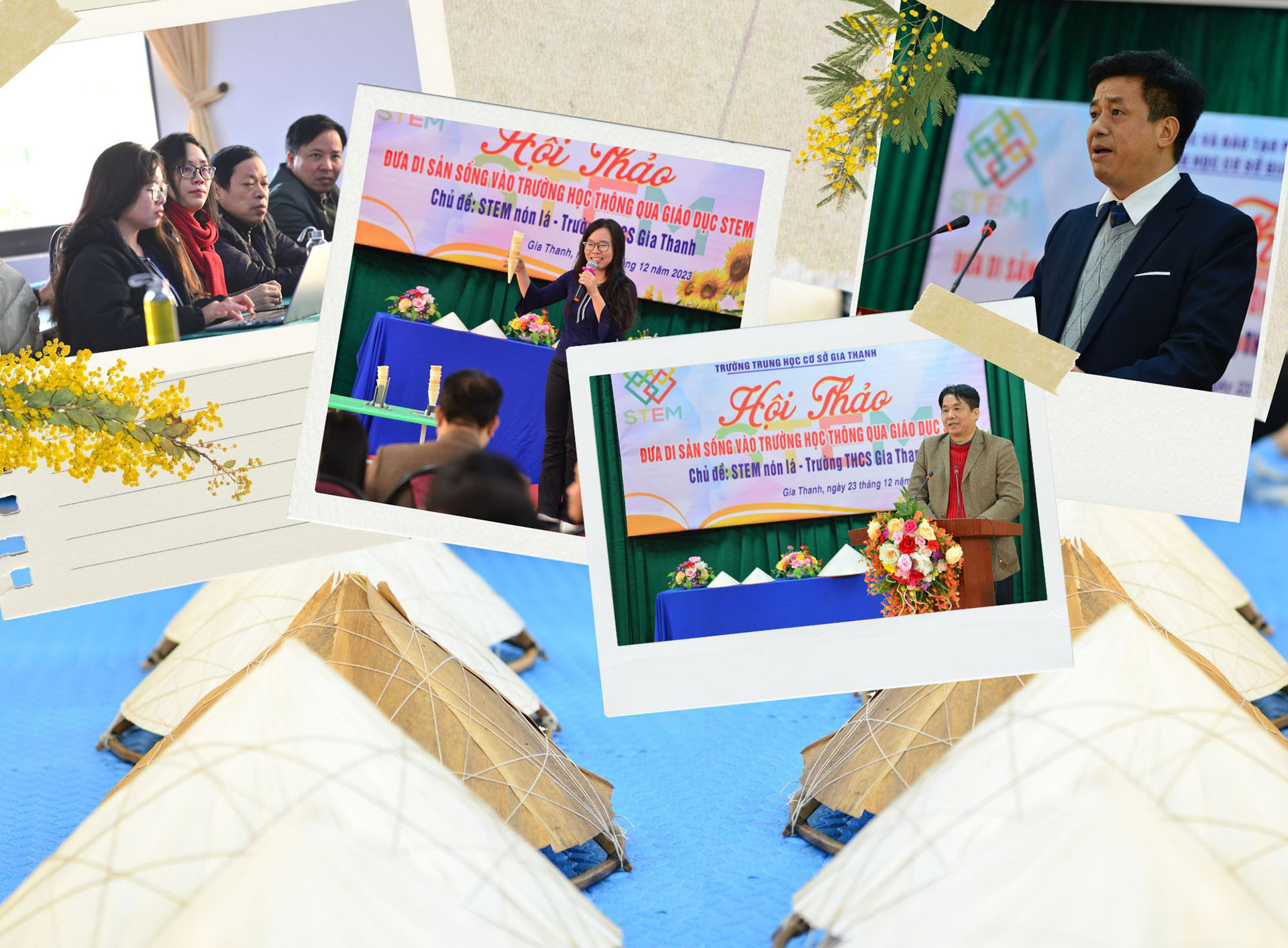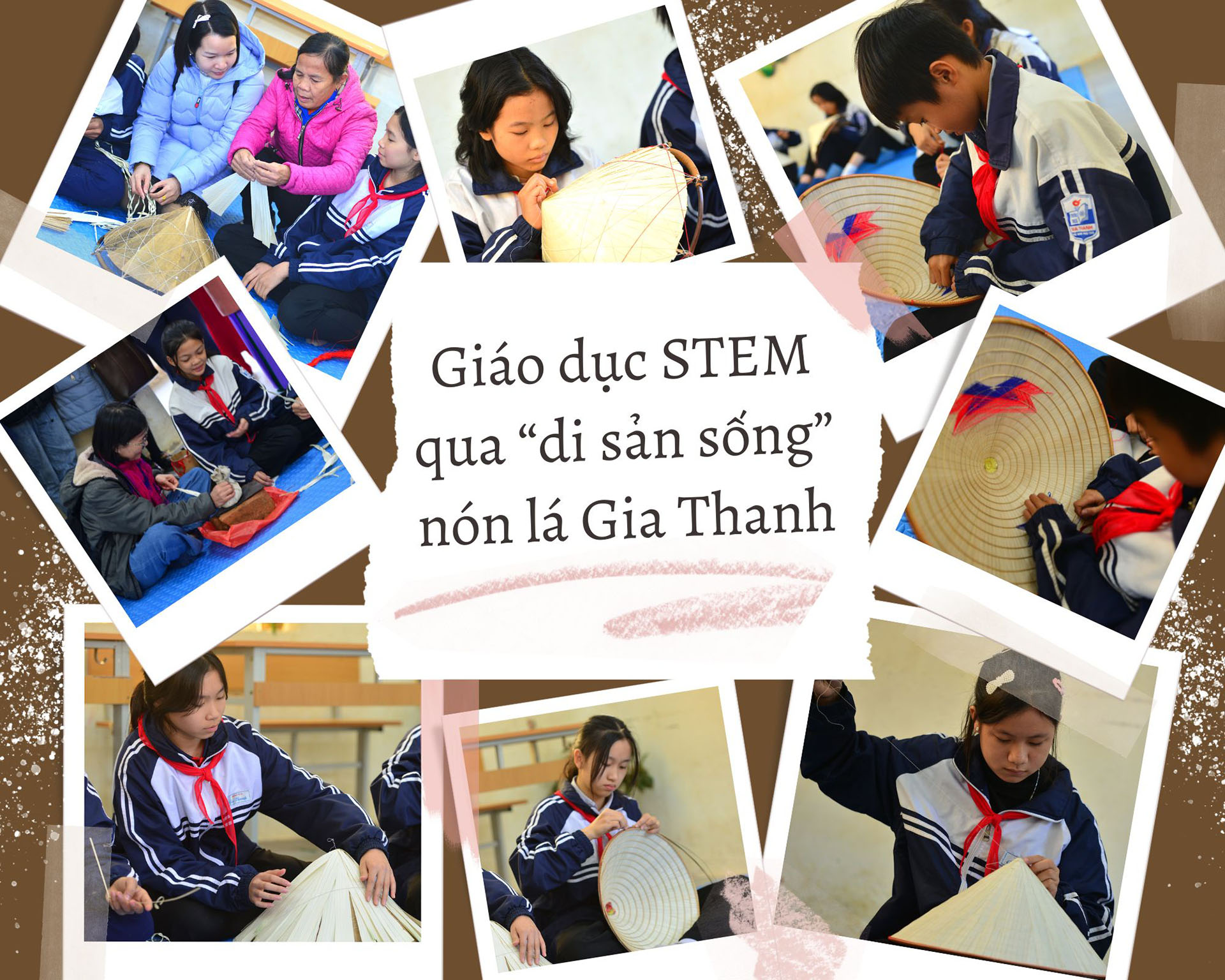The traditional craft of making conical hats in Gia Thanh commune, Phu Ninh mountainous district, Phu Tho province, has had a nearly 100-year-old legacy, providing employment for the locals in the commune. Little did anyone know that this humble conical hat would also bring a $1,000 prize to the students and teachers of Gia Thanh Secondary School when it became one of the six schools worldwide honored by UNESCO. The initiative to introduce the conical hat into the school through STEM education at Gia Thanh Secondary School not only helps preserve and uphold the traditional cultural essence of the craft village but also contributes to promoting the image of Vietnamese conical hats to the world.
Familiarity with life, practicality in the future
“Not just for sheltering from the sun
Not just for fanning away the heat
Not just for holding things
Not just for wearing on the head”
What is it? As Teacher Hoang Quoc Quan, a teacher at Gia Thanh Secondary School, finished the question, a series of eager hands enthusiastically responded, “the conical hat.” Now, learning about the geometry of cones from Mr. Quan flows along vividly and with enthusiasm. Students now not only simply recognize the shape and characteristics of a cone in mathematics, but with their mathematical knowledge, they also learn how to calculate to create a conical hat with various sizes on paper in a simple way through the diameter of the base, height, and slant height.
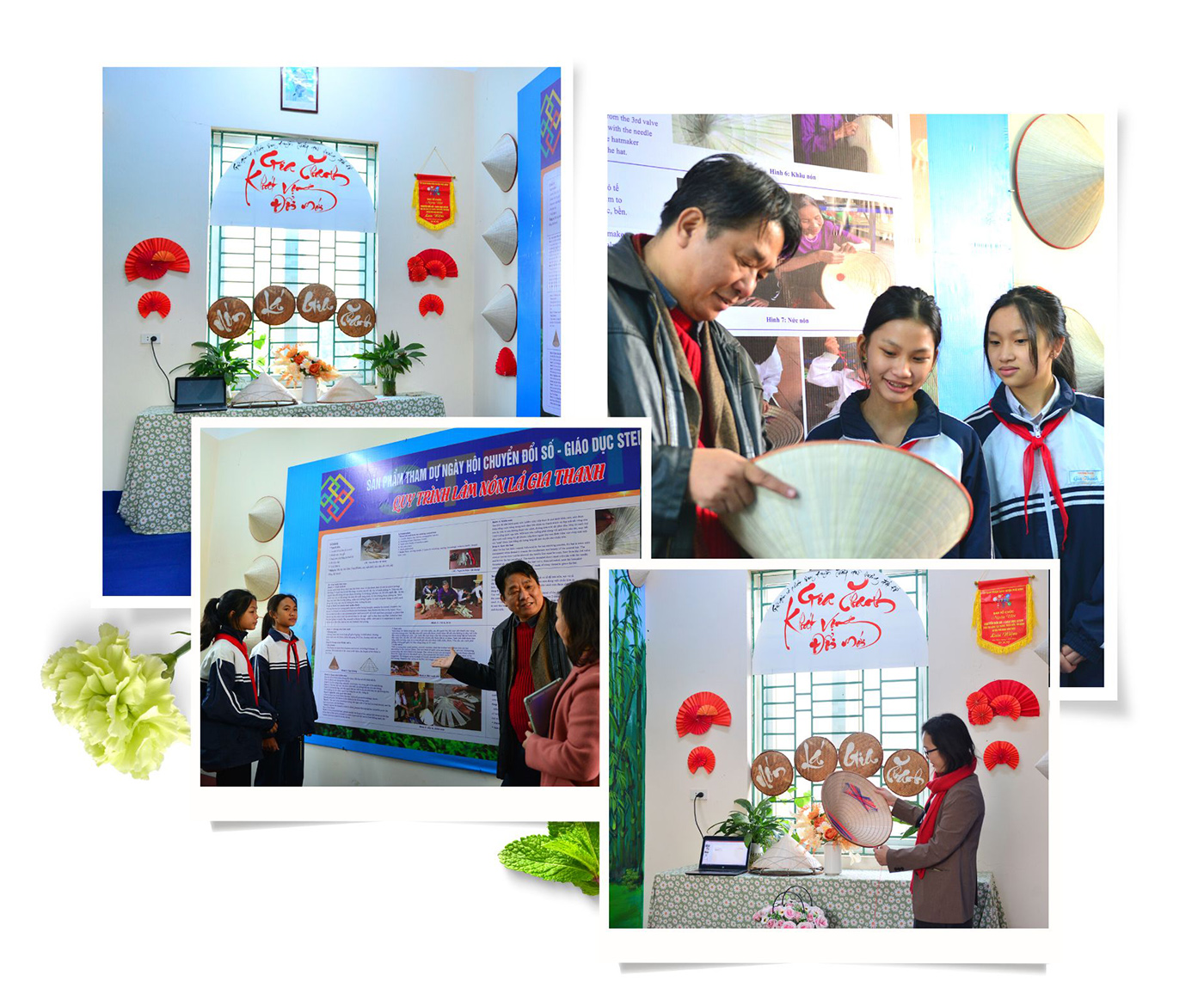
The integration of the living heritage of Gia Thanh conical hats into the STEM program at the school has brought many benefits. Ms. Tran Thi Minh Tam, a Vietnamese language teacher and the coordinator of the school’s Conical Hat STEM Club, shared: “From a practical perspective, we noticed that the craft of making conical hats is gradually fading away, and not many young people today know about conical hats. The Conical Hat STEM lessons focus on changing perceptions about the use of conical hats and developing the craft village. From the teacher’s perspective, incorporating familiar, practical, and meaningful items into lessons is both economical and opens up new directions in teaching and career guidance for students. The students are very enthusiastic and passionate about the lessons. They are inspired and have new ideas to promote and preserve the local heritage values. We can see the smooth and effective interaction between teachers and students.”
The application of Conical Hat STEM teaching was implemented at Gia Thanh Secondary School since 2022. For History class, students see the roles, meanings, origins, and reasons for preserving the value of the traditional craft products of the village. In Math, students apply formulas to calculate areas, circumferences, diameters, or distances between the rings of the hats, the brim of the hats… then design hat molds. In Chemistry, they explore the processing steps, soaking leaves, drying them, preserving them with chemicals to prevent mold and enhance durability. In Fine Arts, students practice drawing the rural landscapes of Phu Tho to decorate the hats, thus fostering their love for their homeland and country.
Student Han Duc Duy, from Class 7A at Gia Thanh Secondary School, said: “The combination of STEM is entertaining, learning while playing, playing while learning is very interesting. I absorb knowledge more easily and remember it longer. The lessons are practical, familiar, yet fresh, vivid, not dry or restrictive. In class, we interact with each other, with teachers; we work in teams, use knowledge and skills to apply them to real-life. From there, we develop cleverness and creativity. We really like such lessons.”

In addition to incorporating conical hats into lessons, Gia Thanh Secondary School regularly organizes activities both within and outside the school. Particularly, they focus on raising awareness to enhance the transfer of skills and vocational learning to preserve the traditional conical hat craft of the locality through learning in the craft village under the guidance of artisans, actively participating in the school’s hat-making club. Currently, the number of members participating in activities at the club accounts for more than half of the entire school (116 out of 223 students).

Present at the conical hat-making class, meticulously guiding each step for students, artisan Trieu Thi Nhuong couldn’t hide her joy and pride when the hat-making craft that her family, as well as many families in Gia Thanh, has been attached to for generations, was introduced into the school. “I am here every week to guide the children in making conical hats. I am very happy because I never thought this simple hat-making craft could be brought into teaching, and to receive a UNESCO award. Seeing students love and diligently make hats, I no longer worry about the traditional craft not being passed on.”
To make a conical hat, the maker has to go through more than 10 meticulous steps, from selecting leaves, drying them, flattening them, making the rim, spinning the hat, then sewing the hat, finishing sewing to remove the hat from the mold, cutting the rim, shaping the top. Each hat is covered twice with leaves, and between the two layers, an additional layer of bamboo shavings or dien… is added to make the hat thicker and more sturdy, avoiding getting wet in the rain. The inside of the hat is skillfully threaded with colored threads to tie the hat straps. When the hat is sold, the hat maker will apply a layer of oil to create a durable, beautiful, and waterproof white conical hat. All the steps, the secrets of the craft are diligently guided and passed down by artisan Trieu Thi Nhuong to the next generation in such classes.
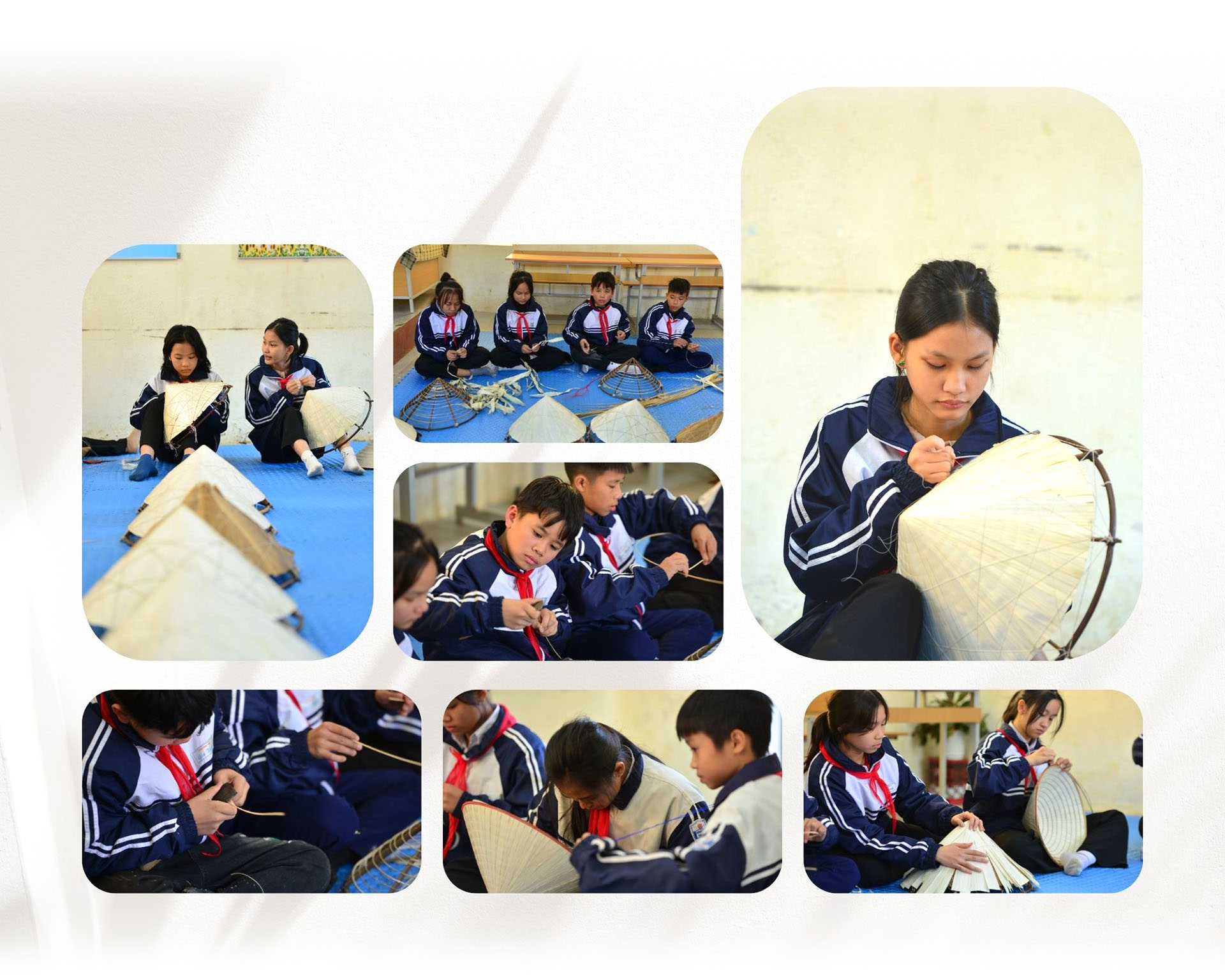
Encouraging creativity and technical thinking
Principal Ngo Ngoc Thuy of Gia Thanh Secondary School emphasizes that setting STEM education goals is the top priority, a crucial task in the comprehensive innovation of general education. To achieve this, the school has flexibly integrated STEM education activities into the teaching plan.
The content of STEM lessons is tightly constructed, following the curriculum and linking with the local heritage. This helps students become more proactive in receiving and applying knowledge in practice through specific learning activities. As a result, their passion for scientific research is stimulated, and their creativity is strongly promoted.
The conical hat is not just a cultural symbol but also a product of traditional scientific and technical knowledge. Students learn about the structure, materials, and the process of making conical hats through practical activities. They have the opportunity to explore the flexibility of materials, the production process, and how conical hats reflect the community’s knowledge. Therefore, in addition to the “Vietnamese Conical Hat” project awarded by UNESCO for the educational solution “Using ‘living heritage’ in teaching” by teachers, students of Gia Thanh Secondary School have also successfully applied the content of conical hats in their scientific research projects. With the project “Preservation and Promotion of the value of the traditional conical hat craft of Gia Thanh through STEM education activities,” students Han Phuong Thao and Luu Thi Thanh Hang, from Class 8B, excellently won the Second Prize in the provincial science research competition in Phu Tho at the end of December 2023.
This shows that integrating conical hats, bringing “living heritage” into teaching in various subjects, is a suitable method that combines modern and traditional approaches to bring positive effects. It creates enthusiasm for learning, stimulates passion, creativity for learners. However, Ms. Tam also shared the biggest challenge in implementation is not everyone fully understanding STEM. In rural areas, not every student has access to information technology. Moreover, sometimes, wanting to create a tool, a project, with a financially poor school will face difficulties. Therefore, both teachers and students have to make use of all the familiar items around them to creatively create learning tools.
Ms. Tran Minh Tam said: “When I received the task assigned by the school, I was excited to be trusted with such an important responsibility, but I also had many concerns and worries. However, during the implementation process, with the guidance and direction of the school administration, along with colleagues and the subject team, we researched, explored, and everything was implemented quite smoothly. STEM not only creates interest for students but also promotes creativity for teachers. After each lesson, the students have products, show creativity. Teaching nowadays is not just about natural science subjects being creative, every subject requires creativity.”
Ms. Tam also revealed that there are many factors to promote the school’s STEM activities, among which is the inspiration from the Vietnam STEM Alliance during the exchange program with the school, which provided suggestions for developing the craft village. The conical hat was not the initial goal from start to finish for teaching, but the school is implementing a plan to preserve heritage through teaching activities. However, the conical hat project helps achieve results in both awareness and action; contributing to maintaining and stimulating tourism, local economic development, entrepreneurial spirit in students. Teachers are still exploring and discovering more products, tools to make lessons more flexible, lively.
Bringing the living heritage of Gia Thanh conical hats into STEM education at Gia Thanh Secondary School is a significant step forward. It not only helps students understand more deeply about the cultural heritage but also stimulates curiosity, creativity, and learning. This combination helps students develop skills not only to enrich knowledge but also life skills and cultural understanding, creating global citizens with integrity.
